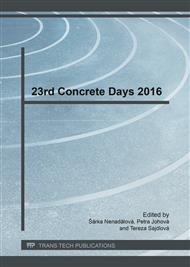p.173
p.178
p.184
p.190
p.198
p.203
p.209
p.215
p.221
Contribution of Settlement of a High-Rise Building with Recession in a Ground Plan to Punching Shear
Abstract:
Construction systems with recession in their ground plan along increasing height of a building are often used in current time. This lay-out is advantageous for the global stability of a building, which acts as a vertical cantilever with a widen socle. Attention must be paid with this type of global lay-out solution, because significant shear forces appear thanks to various types of grand plan. Usually buildings with massive elements, which can bear major of shear forces, don’t have any problem with the global vertical shear forces. Contrarily buildings with slight construction system such as flat slabs supported by columns could be unsafe designed if this effect is not taken account. There is no recommendation or exact approach to this problem in current standards and therefore it only depends on the designer’s approach and their experience. In the paper different types of approaches to the analysis of vertical shear forces and their distribution are presented. They are demonstrated on models with various levels of detailing. The scope of models starts at very simple linear model of whole structure and ends by models which take account of non-linear base supports and construction stages.
Info:
Periodical:
Pages:
198-202
Citation:
Online since:
May 2017
Authors:
Keywords:
Price:
Сopyright:
© 2017 Trans Tech Publications Ltd. All Rights Reserved
Share:
Citation:


